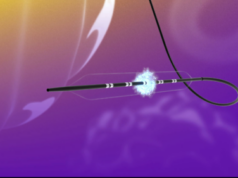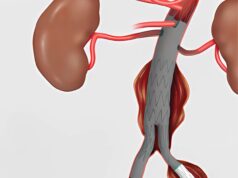So far, drug-eluting stents delay but have failed to conquer restenosis in the SFA according to the latest results of the SIROlimus Coated Cordis SMART Nitinol Self-expandable Stent for the Treatment of Obstructive Superficial Femoral Artery Disease (SIROCCO) II study presented by Stephan Duda at this year’s CIRSE Annual Meeting in Barcelona. Later that week the Femoral STenting in Obstructions study was presented at the TCT meeting by Dierk Scheinert from Leipzig, Germany. This single-center, prospective registry of stenting in the SFA showed stent fractures ranging from 26.9% to 53.3% at 11 months follow-up on plain x-ray. The presenter concluded that before thinking about DES in the SFA, changes in the mechanical performance of nitinol are mandatory.The SIROCCO study is the first drug-eluting stent trial in the periphery sponsored by Cordis and used a sirolimus-eluting nitinol SMART stent. The purpose of the SIROCCO trial was the long-term evaluation of self-expanding sirolimus-eluting nitinol SMART stents versus bare SMART stents in the SFA. Stephan Duda presented the 18-month angiographic results of SIROCCO II at this year’s CIRSE meeting. For SIROCCO I, the binary restenosis rates for the slow-sirolimus release kinetic had appeared very promising up to 18 months (0%). Unfortunately, Duda then announced at last year’s CIRSE annual meeting in Belek, Turkey, that the binary restenosis rate had risen to 40% in the slow sirolimus-eluting stent (SES) group at 24 months.For SIROCCO II the restenosis rates in the slow sirolimus eluting stent arm had also appeared promising initially. Six-month data from the SIROCCO II trial, which enrolled a larger number of patients than the earlier trial, appeared to confirm the finding of SIROCCO I of the benefit of a slow-release formulation at six months with a binary restenosis rate of 0% vs. 7.7% for bare metal stents. Results at nine months published in the CIRSE abstract book showed a continued trend for greater efficacy of the sirolimus eluting stent with in-stent restenosis of 7.7% and 13% in the sirolimus arm and the control group, respectively. However the 18-month Duplex ultrasound data that Duda presented in Barcelona showed non superiority between the DES arm and control with a total in-stent binary restenosis rate of 20.7% in the sirolimus-eluting stent arm and 17.9% rate in the bare metal stent arm (which included one total occlusion).
More encouraging was the reported reduction in the number of stent fractures in SIROCCO I vs. SIROCCO II. There were five reported stent fractures in SIROCCO II at six months and one additional stent fracture detected by the core lab via biplanar flat x-ray at 18 months. This resulted in a 10.7% stent fracture rate in SIROCCO II when a maximum of two stents were used vs. 19% in SIROCCO I when a maximum of three stents were used.
In the same week, the Femoral STenting in Obstructions study was presented at the TCT meeting by Dierk Scheinert from Leipzig, Germany. The study design was a 121-patient, single-center, prospective registry of stenting in the SFA using SMART (Cordis), SelfX (Abbott/Jomed) and Luminexx (Bard) stents for a stenosis greater than 50% diameter after PTA or flow-limiting dissection. Plain x-ray was taken at each clinical follow-up to assess fracture. The primary patency rates ranged from 78% to 27% at 12 months (78% for the SMART stent, 60% for SelfX and 27% for Luminexx). Stent fractures ranged from 26.9% to 53.3% at 11 months follow-up on x-ray (26.9% for SMART, 29.2% for SelfX and 53.3% for Luminexx).
Scheinert showed patency tables for the different stents comparing lesions with fractured and unfractured stents. SMART stents showed no statistical difference whereas SelfX and Luminexx stents with fractures had statistically significantly lower patency rates than the unfractured stents.
Dr Scheinert therefore concluded that stent fractures have a clinical impact and that the primary patency rate of stented segments is clearly related to the prevalence of fractures. Stent fractures are associated with restenosis or re-occlusions in at least two thirds of the cases. Not all nitinol stents are equal. Finally, Scheinert stated that before thinking about DES in the SFA, changes in the mechanical performance of nitinol are mandatory.












